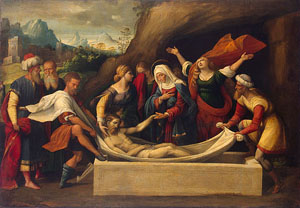| Official internet-portal of St. Petersburg, cultural capital of Russia | |
| Petersburg CITY / Guide to St. Petersburg, Russia | http://petersburgcity.com |
|
Printed from: http://petersburgcity.com/news/culture/2007/03/21/carofalo/ Culture news, 21.03.2007 15:58 Garofalo - the Ferrara Raphael 13 March 2007 - 1 July 2007
13 March 2007 - 1 July 2007
The exhibition in the Rotunda of the State Hermitage is deThe exhibition in the Twelve Column Hall of the New Hermitage is dedicated to Benvenuto Tisi da Garfalo (1476?-1559). The exhibition presents around 20 items from the collection of the State Hermitage.
Scholars believe that Garofalo's first teacher was the local painter Domenico Panetti. Beginning in 1497, Benvenuto studied under Boccaccio Boccacino. Both these artists are represented in the exhibition: Panetti, by a strict and expressive Female Portrait; Boccacino, by two paintings in which we can see the influence of Venetian painting that also influenced the early work of Tisi. However, the decisive factor for him was getting to know Raphael's paintings in the Vatican during his visit to Rome in the years 1510-1512. From this moment on, in Benvenuto's work the influence of the great master was constantly felt.
In 1531 Garofalo suffered a misfortune: he became blind in one eye and in 1550 he finally lost his vision entirely.
Garofalo's The Marriage in Cana is dated precisely 1531. It was part of a series of paintings that the artist worked on for many years for free, "solely out of love for mankind…including all holidays, when in the monastery and in the San Bernadino nunnery." Four canvases from this series were purchased for the Hermitage by Nicholas I. Of these, three may be seen in the exhibition: The Marriage at Cana, The Allegory of Old and New Testaments and The Bearing of the Cross. The fourth painting, The Miracle of Bread and Fish, was transferred in 1931 to the Far Eastern Art Museum of Khabarovsk.
The prototype of the architecture in the background of The Marriage in Cana was the church in Raphael's fresco The School of Athens in the Vatican. Garofalo joined two worlds, the legendary Evangelical world and the world of his own day.
The iconography of his Allegory of Old and New Testaments is unusual. The canvas was especially restored for the exhibition and visitors will see it for the first time.
Alongside monumental canvases by Garofalo, the exhibition also shows his smaller paintings, including The Entombment, the first work of Italian painting to enter Russia during the reign of Peter the Great. It was then considered to be a Raphael.
The beginnings of Ferrara art can be appreciated from the work of an unknown 15th century master, The Generosity of Alexander the Great. The exhibition includes works by Francesco Francia, and Lorenzo Costa, who gave Ferrera painting a "decisive impulse to spread the new language based on clear musical construction and on the perspectives of great balanced compositions."
When the Female Portrait entered the museum, Raphael Santi was considered to be its author. At present, this work is attributed to Lorenzo Costa.
Parma-born Gian Francesco Meineri belonged to the Ferrara school. The painting Christ Bearing the Cross is among the main achievements of Meineri in developing this subject.
Garofalo collaborated with the greatest master of the local school, Dosso Dossi. Dosso's work Sivilla is splendid in terms of colors and expressiveness of the image. Dosso's younger brother Battista was the author of the monumental canvas Nymph at the Spring. The figure of a nymph is imbued with images from paintings by the Venetian painters Giorgione and Titian, as well as revealing familiarity with the Roman sculpture of Sleeping Ariadne. Battista, like Dosso, worked together with Garofalo.
The career of Benvenuto Tisi da Garofalo developed during the first half of the 16th century, the period of the flowering and then waning of the Italian Renaissance. The master followed a path from rather conservative early works to the time of maturity, onwards to the achievement of great freedom, in which he was helped greatly by getting to know the painting of Santi. Partly for this reason it was precisely thanks to Garofalo, the local Raphael, that the Ferrara school entered upon the path of the High Renaissance.
The curator of the exhibition and author of the illustrated scholarly catalogue issued by the State Hermitage Publishing House is Tatyana Kustodieva, leading researcher of the Department of Western European Fine Arts and doctor of art history.
News source: hermitagemuseum.org
| |
| (c) 2000 PetersburgCity.com E-mail: contact@petersburgcity.com | |